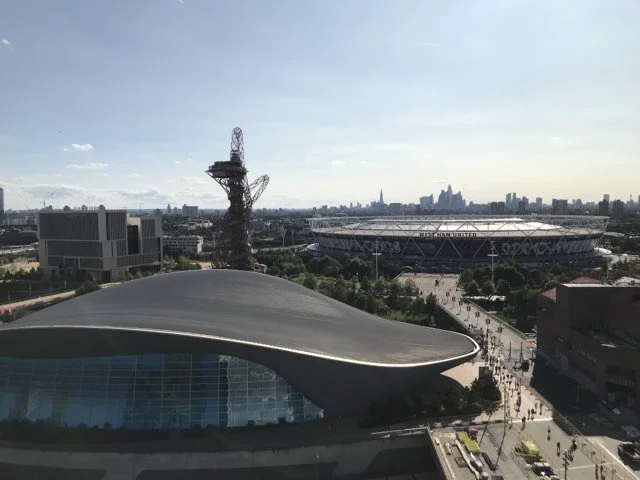Queen Elizabeth Olympic Park, August 2023.
Earlier this month I stood on a 10th floor roof terrace, looking out over the Queen Elizabeth Olympic Park. In front of me were the sweeping curves of the aquatics centre, the delicate frame of the London Stadium and the frankly disturbing tangle of the Orbital.
With around twenty other women, I was at the She is Sustainable Netwalk in the Park event and we were hosted and expertly guided by the very knowledgeable and delightful Ruth Lin Wong Holmes of the Queen Elizabeth Olympic Park and London Legacy Development Corporation. She showed us detailed planting choices and biodiversity successes, and told us a lot about community engagement which informs things like the placement of benches and the design of a new youth shelter.
Phases of development, London Olympics' style
But the thing that struck me most, was Ruth's explanation of the phases of development planning which have informed the long-term thinking about this area of East London. Perhaps there's a transferable metaphor here we can apply to our lives, careers, organisations or projects. Or even to the transition to a low-carbon society.
Underlying geology, hydrology, physicality - the Olympic Park is at the southern end of the Lee Valley, just north of where the Lee joins the Thames. Although the valley is gentle and broad, it can channel a lot of water and although it enters the Thames upstream of the Thames Flood Barrier, there can still be impacts from high tides. It may be hidden beneath centuries of human intervention, but there is still a landscape of hillocks and channels. There's also the direction of the sun (which we experienced a lot of).
History of uses - this part of the Lee Valley, with its reliable water flow and proximity to London, was home to tanneries, sweet factories and Yardley soap. Carpenters Road used to be known rather poetically, as the street of a thousand smells. What this meant for the park was a very large amount of contaminated soil which needed 'cooking', removing or covering with a layer of clay. An unexpected historical influence is the protected view of St Paul's Cathedral from Richmond Park way over in west London. This dates way back to 1710, and is influencing the height of new buildings in the Olympic Park area today.
Olympic development - there's nothing quite like delivering the Olympics to focus the minds of all the partners involved. It's a pretty solid deadline, and your work is in the global spotlight. So there were some things which absolutely had to be delivered on time and at the quality needed.
'Meanwhile' uses - like the mobile garden, or the site at Hackney Bridge, where start-up makers, retailers and food businesses can use the space while the LDDC waits for the right time to build new homes there. There's a risk, of course, that the meanwhile uses will be so popular that people won't want them to stop.
Legacy development - this comes in two kinds. The first is things which were built for the Olympics and have been recognisably repurposed, like the London Stadium or the athlete's village which is now called East Village, and began housing residents in 2013, just a year after the Games. The buildings in the village were designed and built with their long-term use in mind, and needed relatively little modification. The second kind of legacy development is buildings and 'public realm' which have been built from scratch following the Olympics, and are intended to serve long-term needs. We saw the cultural cluster called East Bank, which includes buildings for the V&A, London College of Fashion, Sadlers' Wells and a BBC music site.
It was exciting to hear how much expert work has gone into planning and replanning all of this, responding to client needs, the site itself, political whim, economic ups and downs, but retaining some very clear simple intentions of delivering for the Olympics and then delivering a legacy to be proud of. (You can tell I was impressed!)
Phases of development - what can we take from this?
Maybe there's a useful framework for thinking about long-terms goals and short-term goals together, metaphorically as well as a kind of project planning checklist.
Underlying, immovable context - the Earth and its processes.
History of human uses - we can't change the past. How can we acknowledge and respond to it?
Urgent, current commitments - what's our equivalent of the Olympics, which we're committed to delivering or doing right now? Which of these are really inflexible? (The Tokyo Olympics were put back a year due to Covid, so it wasn't an immovable deadline after all.)
Meanwhile uses - what can we usefully fit in, knowing it won't be forever?
Legacy - what are the really long-term things we want to work towards, and how do they need to inform the things we do in (3) and (4)?
This is what I took from Ruth's talk. It may not be the way she would explain it, so blame me not her if I have interpreted it too far from how the LLDC actually does things! Thanks again to Ruth for hosting this event and sharing all her insight with us. And for taking us to the amazing Tumbling Bay adventure playground with its beautiful wild-looking timber climbing structures, which was a highlight for me.
She is Sustainable reaches the adventure playground.


